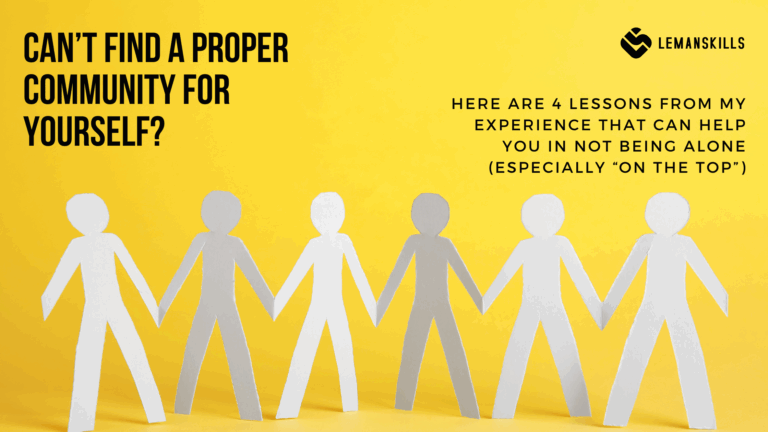Sometimes we all feel that it’s just too much. Too many tasks on the list that never ends. Too many expectations from the outside world. Too much pressure to be perfect, to manage doing everything and to not lose any touch of optimism, level of energy or creativity. Too many distractions, phone calls, messages, Teams meetings – all of those things that stop us from being focused and concentrated on what really matters. And where among all those things journaling can find its place?
It can help even when we are super organized, efficient, with a good balance in our lives, we can struggle sometimes. Our brains are not programmed to process this amount of data and stimulants we get every day, so it shouldn’t be a surprise that we feel just tired of being preoccupied. And journaling is a great tool to ease the pain, improve a lot of areas in your life and what’s most important – keep your mind calm and free of being overwhelmed.
How does it work for me? Here are few things I hope will be an inspiration to see what you can life to live it better.
Journaling is a part of my morning routine
I am a morning person, so a morning routine is one of my favorite parts of the day. I get up at 6AM every day, do my workout session and then have a breakfast and I journal a little bit. I’ve added journaling to my morning routine almost 3 years ago, after participating in Brand Minds Conference where one of the speakers introduced the Miracle Morning idea. I’ve started small, wrote down elements from the exercise. And then, I’ve realized how much it helps me organizing my thoughts and sometimes let off steam and frustrations without hurting other people.
It takes me 5-6 minutes every day, not more, and is a great addition to all of the elements that make my morning full and structured.
Journaling keeps me organized
When I journal, I always create a space to make a list of the gains from yesterday and 3 things I want to achieve today (I wrote more about it here). Those 3 things I want to gain in a certain day help me to be more focused on what is really important for me, and checking if I achieved what I wanted the previous day gives me information about myself. Was I focused enough? What can I do differently today to gain what I want and need?
You can add a structure of your day there, the main things you want to do for yourself in different areas. It can be interesting to divide the elements in categories: work, development, health, relations, food etc. That way you will see day by day how you spend your time, and maybe which areas of your life are overinvested and underinvested. You can ask yourself then: why is that? Is it harder for me to do some things than others? What can I do to redirect my energy on those areas that are important, but I don’t spend a lot of time on them at the moment? Sometimes just a change of focus on certain elements can help you in seeing things differently, from another angle.
It helps me to regulate emotions
We’re all getting stressed, frustrated, without an influence on what we want to have an influence on. We’re getting mad at other people (close to us or really far from us, i.e. the politicians or CEOs), angry, scared, disappointed or sad. And of course, we’re getting mad, frustrated, angry at ourselves.
These are all human, normal emotions. We were taught to not to name them, feel them, to get rid of them as fast as possible. Because FEELINGS ARE BAD. FEELINGS ARE UNPROFESSIONAL.
Don’t cry, be man. Don’t be a sissy.
Don’t get angry, girls are supposed to be nice and smiley.
Sounds familiar?
Those things we hear as children stay with us and we believe them as adults, the most oftenly – unconsciously. Even the most developed, wise, mindful people on the planet have those thoughts in their heads.
Journaling helps me to name what I feel, to take a step back to reflect on that and make a former decision about what I want to do with that emotion. Recognition is a first step of a high level of mental health, to live in a harmony with yourself.
It is a way to discover things

Sometimes when I write, those thoughts, sentences or bullet points are just coming to my mind and fingers. And pretty often I don’t expect some of them to be there, on the piece of paper or in doc file, they just appear. One thought leads to another and unlock other ideas, connect the dots between things I never thought can be linked together.
Journaling can be a great tool to train the creativity muscle, to get yourself carried away by the flow and just let the stream of the thoughts go. It also can be just a fun, easy experience, but it also can be hard, eye-opening or triggering in some way. Regardless of that, you can discover something through it. And you can be closer to yourself, you can free the potential or skills you never knew are there.
Once they are discovered, you can decide what to do with them. But if you don’t know what really is inside of you, how you can make a decision about anything?
The bottom line
For a long time I’ve only read about journaling. We can find online multiple articles about the advantages of it. Or about how much it is a life changer or how it can be applicable to the life of every single person. Now I know that it’s not for everybody, but it works for me, and I gladly share the experience from what I’ve learned from the whole process.
Give it a chance. Give yourself a gift of a beautiful notebook or journal. Make it a 5-minute time only for you, when you can reflect on your day, or plan another one that is in front of you. When you can sum up what you’ve achieved or make a list of things that you are grateful for. It will give you a space to think in this world of infinite rush and distractions.




